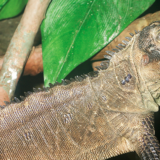RANGE
From northern South America, in the Guianas, throughout the tropical rainforests of South America, east of the Andes and Orinoco Basin. They are found as far south as Argentina.
HABITAT
Anacondas prefer being near water and thus are found mainly in tropical rainforest regions; however, they have also been found in savannas, grasslands, deciduous forests, and scrub forest regions. Many also frequent shallow caves near riverbanks and can be seen basking along roots of trees lining riverbanks. On land, in dryer areas, they can have problems with ticks and are unable to move as fast, so they prefer staying submerged in water.
SIZE
Maximum 17–25 feet.
LIFE EXPECTANCY
Anacondas have been known to live 30+ years.
REPRODUCTION
- Normally Anacondas are solitary.
- When a female is ready for breeding she will emit pheromones that attract males living in the area to her. Males have been observed “licking” the air to pick up the chemical presence.
- Courtship can last several months. Copulation usually takes place in the water.
- Gestation is approximately 6 months. Anacondas are viviparous, meaning they bear live young. A typical litter contains 20 to 40 2-foot-long babies, although they have been known to have as many as 100. Young are easy prey to a variety of predators.
- Young generally refuse food for the first few months of life. Within hours after birth the young can swim, hunt and care for themselves.
- The young grow rapidly and reach sexual maturity in about 3–4 years. They continue to grow throughout their life.
DIET
Carnivorous. They have been observed feeding on rodents, birds, frogs, young tapir, capybaras, deer, peccaries, fish, turtles, birds, sheep, dogs and aquatic reptiles. Only rarely have they been known to go after humans.
BEHAVIOR
- Anacondas prefer to spend most of their time in water, where they lay in wait for prey. They can stay submerged for up to 10 minutes.
- Like all members of the Boa Family, Anacondas are constrictors, meaning they grab prey with their teeth, wrap around the animal and tighten on it (constricting) until the animal can no longer breathe and thus suffocates.
- Animals are consumed head first.
- Unlike in the movies, they have rarely been known to go after humans and generally move away when humans are present.
POINTS OF INTEREST
- There are two types of Anaconda at the Louisville Zoo. The green and the yellow anaconda. The green is usually darker in color with black patches. The yellow is lighter in color.
- The name “Anaconda” actually derives from the Sinhalese (an Indian language) referring to the python. It is not known how the term became associated with the South American snake.
- The Tamil word for Anaconda is “Anaikolra” which means “elephant killer”. Early Spanish settlers referred to this snake as “Matatoro” or “bull killer”.
- Anacondas are excellent swimmers and hunt from the water, many of their prey are drowned before they succumb to constriction.
STATUS
CITES Appendix II







